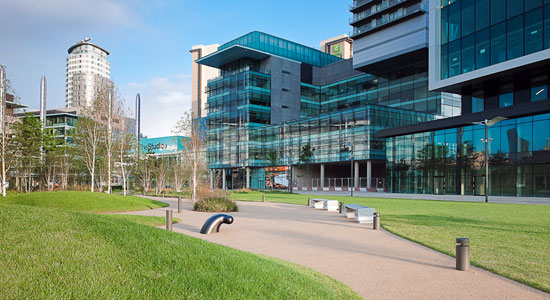 Barry Adamson is in a weird position. After winning acclaim for the noir-cinematic atmospheres of solo projects such as Moss Side Story and the mash-up of Back To The Cat, writing songs for directors such as Danny Boyle, Oliver Stone and David Lynch, and composing film scores for Delusion and Out Of Depth, the 53-year-old writer/multi-instrumentalist found himself directing, writing and acting in his own movie with 2011’s The Therapist. “I’m a marketing man’s nightmare,” he jokes. To make things more intense, Adamson—post-punk’s most legendary bassist, with roles in Magazine and Nick Cave’s Bad Seeds—returned to the scene of the live-music crime by playing gigs with Howard Devoto’s re-united Magazine after decades of being a lone wolf. What was he thinking? And how did all of that recent interaction inspire his newest project, the aggressive Destination? Read our new Q&A with him below. Adamson will also be guest editing magnetmagazine.com all week.
Barry Adamson is in a weird position. After winning acclaim for the noir-cinematic atmospheres of solo projects such as Moss Side Story and the mash-up of Back To The Cat, writing songs for directors such as Danny Boyle, Oliver Stone and David Lynch, and composing film scores for Delusion and Out Of Depth, the 53-year-old writer/multi-instrumentalist found himself directing, writing and acting in his own movie with 2011’s The Therapist. “I’m a marketing man’s nightmare,” he jokes. To make things more intense, Adamson—post-punk’s most legendary bassist, with roles in Magazine and Nick Cave’s Bad Seeds—returned to the scene of the live-music crime by playing gigs with Howard Devoto’s re-united Magazine after decades of being a lone wolf. What was he thinking? And how did all of that recent interaction inspire his newest project, the aggressive Destination? Read our new Q&A with him below. Adamson will also be guest editing magnetmagazine.com all week.

Adamson: Dystopian, bleak, man-made landscape and new home of the BBC and all things TV and radio, which reverberates like a J. G. Ballard novel and even the name sounds like one, MediaCityUK is a vision of the future, now, newly located in Salford quays, just north of Manchester. It is a brand-new media district supporting a whole host of like-minded businesses; a true digital hub, inspired by media clusters in cities like Dubai and Singapore. The blurb goes, “By offering or facilitating high-speed connectivity, a purpose-built infrastructure, changes in supply chain, and flexible training and development for staff, we hope to help you embrace—and exploit—every opportunity.”
According to the company’s website, “For much of the twentieth century the area was dominated by Salford Docks, a lynchpin of the region’s industrial might and once one of the country’s busiest dock systems. Opened by Queen Victoria in 1894, it was the terminal docks of the Manchester Ship Canal and handled millions of tonnes of cargo each year. Along with many of its counterparts, Salford Docks suffered from the decline of heavy industry and the containerisation of shipping. It was finally closed in 1982, leaving the disused piers and waterways at risk of becoming a wasteland. But in 1985 the Salford Quays Development Plan was unveiled, signalling the start of one of the UK’s first—and biggest—urban regeneration projects. During the intervening 25 years the area has made the gradual transition from dockland to destination, with attractions like The Lowry arts centre and Imperial War Museum North helping to bring in millions of tourists each year.”
MediaCityUK bristles with Ballardian values and apart from wanting to live there, it will be interesting to see this futuristic vision develop and to witness whether its influence on creativity will change the artistic landscape of the Northwest as well as the skyline.
Video after the jump.






